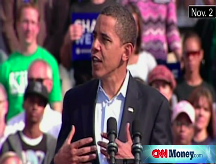Obama thinks big in budget
Six weeks in, Obama calls for sweeping reform in 2010 budget proposal. Next week, administration officials and lawmakers discuss the details.
NEW YORK (CNNMoney.com) -- President Obama last week -- his sixth in office -- showed his hand on how he hopes to shape the government's federal budget and the U.S. economy along the way.
In a speech that bore the hallmarks of a state of the union address, Obama on Tuesday told Congress about the challenges facing the economy while also saying that "we will recover."
"Now is the time to act boldly and wisely to not only revive this economy, but to build a new foundation for lasting prosperity," he said.
Two days later, Obama added details of his ambitious agendas for energy, health care and tax policy in a 10-year budget outline.
Under the terms of Obama's budget plan, tax breaks for high income earners would expire while low and middle income Americans would see some tax relief.
The administration expects the budget deficit, already above $1 trillion, to swell to $1.75 trillion this year. Obama has pledged, however, to cut the deficit in half by 2013.
Among the new programs created under the budget is a $634 billion health care reserve fund aimed at making coverage more universal and reduced insurance premiums.
This coming week, Obama has called for a health care summit with lawmakers, industry groups and academics to discuss ways to reform health care policy.
In addition to the summit, two top administration officials will testify before Congress on the budget proposal.
On Tuesday, Treasury Secretary Tim Geithner goes before the House Ways and Means Committee, and Peter Orszag, director of the White House Office of Management and Budget, will address the House Budget Committee.
Orszag returns to Capitol Hill on Thursday for a hearing on accountability and transparency in the administration's $787 economic stimulus bill with the Senate Homeland Security and Governmental Affairs Committee.
Also next week, Obama's $75 billion foreclosure prevention program officially gets underway. The effort, announced last week, is aimed at helping 9 million Americans suffering from falling home prices and unaffordable mortgage payments.
100-day scorecard: Week 6
CNNMoney.com will continue to track Obama's first 100 days in office and keep score of the government's unprecedented efforts to fix the ailing economy. (Last week's article is available here.)
Bold action: In his first speech to a joint session of Congress on Tuesday, Obama sought to reassure Americans that the dire economic challenges facing the country will eventually be overcome.
Obama said the administration has identified $2 trillion in government spending cuts that can be made over the next decade. But he also discussed plans to invest billions in renewable energy, education and health care reform.
He reiterated his commitment to holding accountable executives of any banks receiving taxpayer funds.
"This time, CEOs won't be able to use taxpayer money to pad their paychecks or buy fancy drapes or disappear on a private jet," Obama said. "Those days are over."
Budget blueprint: After setting the stage in Tuesday's speech, Obama unveiled the details of his fiscal 2010 budget proposal on Thursday.
While Obama has pledged to halve the $1 trillion-plus deficit he inherited over the next 5 years, the administration said it expects a deficit of $1.75 trillion in fiscal 2009.
The proposal calls for $3.6 trillion in spending in 2010, and estimates that $2.4 trillion in revenue will be collected.
On the spending side, the plan sets aside $250 billion for additional money to stabilize the financial system and $634 billion for a health care reserve fund.
To reduce the deficit, the plan would phase out tax cuts on high income earners by 2011. The White House estimates letting the cuts expire could raise $637 billion over 10 years.
Additionally, it would allow the capital gains tax rate to return to 20% from the current 15% rate.
At the same time, Obama's proposal to extend tax breaks to lower and middle income families is estimated to increase the deficit by more than $900 billion during the same 10 year period. ![]()



